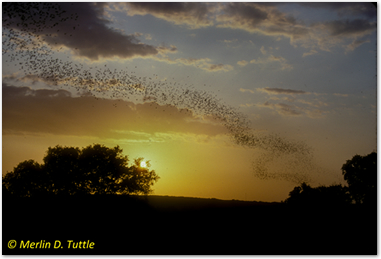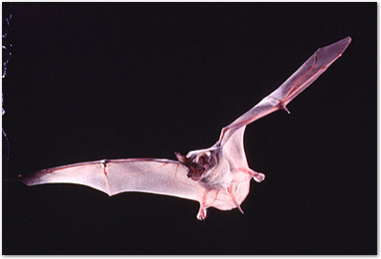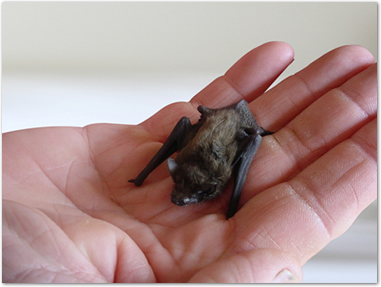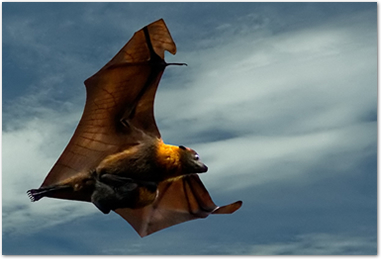BAT Facts
|
|
|
Just around the corner from our offices at Bat Cave Executive Search, lies the original entrance to the famous Bracken Bat Cave. For generations, a 3 mile trip down this dusty Texas ranch road has taken intrigued visitors to the summer residence for millions of Mexican free-tail bats. With a population of 10 to 20 million bats, the Bracken Cave is the largest concentrated gathering of mammals on Planet Earth. Fortunately for them, the cave and several hundred surrounding acres are owned (and carefully stewarded) by Bat Conservation International. Though opportunities to view their evening “emergence” are quite limited, there are still a thousand or so visitors per year – that get to see these impressive creatures swirl out of the Bracken Cave and darken the sky, as they begin their evening feast on moths, mosquitos and other pesky bugs within 100 miles of the cave. While most of the bats have safely returned during the dark of night, early rising residents regularly observe straggling Mexican free-tails just after sunrise - on their flight back to the Cave.
Here are some BAT Facts that we found intriguing:
- There are over 1,300 species of bats – globally, ranging in size from as small as a butterfly, to the size of a Bald Eagle, with 6 feet wingspans.
|
|
|
- All the bats in the Bracken Cave are Mexican Free-Tails (Tadarida Brasiliensus)
- Farmers across South Texas are grateful that the Bats of Bracken Cave spend their evenings consuming massive quantities of the damaging Corn Earworm moth, which is also known as the “cotton bollworm” and the “tomato fruit worm”. Estimated savings to area farmers is over $700,000/year…not to mention the reduced need for harmful pesticides.
- 10 Million Bats Can Eat a Lot of Bugs: The 10 to 20 million Mexican free-tailed bats of Bracken Cave can eat approximately 200 TONS of insects in a single summer night!
- Just one pup a year: Bats reproduce slowly, with females of most species giving birth to only one pup per year. Bracken Cave is a maternal cave. Amazingly, these Mexican free-tail moms can identify their pups’ voice, amongst millions of other bawling baby bats.
- Bats are surprisingly clean: Bats carefully groom themselves and are among the cleanest of animals.
- They are not blind: Much to most people’s surprise, bats are not blind. Not only do they see as well as many other mammals, they also utilize a type of radar known as “echolocation”.
- Echolocation allows these bats to navigate away from an approaching stalactite in pitch black while flying 50 mph, and to detect an object as small as a human hair.
- No Vampire Bats in America: These extremely rare bats represent far less than 1% of all bats, and are only found living in Latin America.
- Incredibly Important Pollinators: The global bat population does a tremendous service to both the ecology and the people of planet Earth. For example, by pollinating flowers and dispersing seeds, bats in some tropical areas account for up 98% of early reforestation on cleared land. Nearly 100 species of agave plants and cacti, including the famous Saguaro Cactus – are pollinated by bats.
- Tremendous Producers of Fertilizer: Organic farmers around the world are usually thrilled to have a large bat cave in the area, as the bat droppings (a.k.a. guano) are extremely valuable as a rich natural fertilizer. The Bracken Cave is no exception, and though we would not want to be recruited as part time harvesters of this tremendous resource – the owners of this search firm do certainly use this rich fertilizer on our own gardens. Bat guano also supports bacteria that is useful in producing some types of antibiotics.
- Flesh Eating Beetles: Miners of this resource need to be careful, properly clothed, and wise, regarding how and when they descend into the mine shaft of the Bracken Cave – as there are actually flesh-eating beetles on the floor of the cave – to contend with, during certain times of the year.
|
|
|
- The Bracken Cave – Part of World War 2’s Top Secret Weapon History. Just over 70 years ago, as scientists from the United States, Canada and the U.K. were combining their intellectual forces to develop the world’s first nuclear bomb, American scientists were perfecting another secret weapon…in South Texas. This weapon, much different in nature, and thousands of times smaller, was an incendiary, altitude sensitive bat-bomb, which the US Military was planning to strap onto a large number of Bracken Cave Mexican free-tails. To be fair, there were definitely other caves involved in the project (Carlsbad Caverns, to name one), but Bracken (the largest) was certainly one of the most involved. While the bomb developed for Hiroshima (code name “Little Boy”) weighed 4 tons, these tiny bat-born fire starters weighed considerably less than one ounce. This project (which would have caused massive & widespread fires after thousands of bomb laden bats were released from an Allied bomber at high altitude) gained favor in the eyes of President Roosevelt, because of its potential to greatly decrease the need for a human invasion of the Japanese mainland – something that would have cost a tremendous number of Allied casualties. The code name for the development of this top-secret weapon was Project X-Ray. While the Army got the project started, they eventually handed it off to the combined efforts of the US Navy and the Marines. The research, testing and refinement of this bat-strategy took a tremendous amount of wartime resources. After 27 months, $2 million (in 1940’s dollars!), and the “successful” burning down of some brand new military barracks and a control tower during “testing”…the US Military finally had enough. They decided to drop the project in the summer of 1944, probably because the higher-ups knew that the bugs were almost worked out, on something called the Manhattan Project. It’s hard to imagine that this sleepy South Texas road had US Marines marching up and down it to protect their Secret Bat-Weapon, but that’s exactly what was happening - right here in front of our offices on Bat Cave Road - during the summer of 1943.
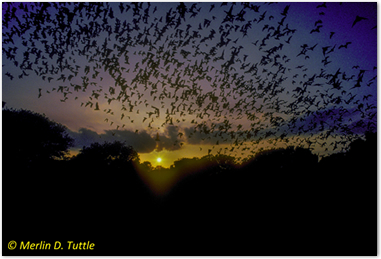 Other Frequently Asked Bat-Questions:
Other Frequently Asked Bat-Questions:
Question: Have you ever been bothered by any of those 20 million bats flying over your head all summer long - every year?
Answer: No. They occasionally get caught in our fireplace, and a stray bat who didn’t have enough energy to make it home, might die – hanging on to the underside of a protruding rock on the side of our house. We like the fact that they fly over and eat the mosquitos in our area. That is one tremendous reason to thank God for the Bats in Bracken Cave!
|
|
Question: What is the smallest species of bat?
Answer: The Bumblebee bat is the world’s smallest bat, and also the world’s smallest mammal – based on skull size. This tiny little guy weighs only 2 grams, so it would take about 29 of them to make one ounce!
Question: Do the Bracken Bats stay in the cave all year?
Answer: No, they fly south to Mexico – for the winter. They are only here from March to November.
|
|
|
Question: What is the largest species of bat?
Answer: Flying foxes are classified in the genus Pteropus. They belong to what is called the “megabat” suborder. Megachiroptera, are the largest bats in the world. They are commonly known as flying foxes or “fruit bats”. They live in the tropics and subtropics of Asia, Australia, East Africa, and a number of remote islands in the Indian and Pacific Oceans. There are at least 60 species in this genus, and fortunately for us humans - all species of flying foxes feed only on nectar, blossom, pollen, and fruit. This explains their limited tropical distribution, as several thousand flying foxes would certainly need a tropical environment to keep their stomachs full!
We found it interesting that they do not possess echolocation - which helps other species of bats to accurately track and catch insects in mid-air. Instead, smell and eyesight are very well-developed in flying foxes. Feeding ranges can reach up to 40 miles. When it locates food, the flying fox "crashes" into foliage and grabs it. It may also catch hold of a branch with its hind feet, and swing upside down. Once attached and hanging, the fox draws food to its mouth with one of its hind feet or with the clawed thumbs at the top of its wings. Mouse over the flying fox photo on right – and you can understand why they call these guys “megabats”.
Our Heartfelt Thanks to Mr. Tuttle for our 2 Beautiful Sunset Photos
 Our gratitude goes out to Mr. Merlin D. Tuttle, the original Founder of Bat Conservation International (BCI) and a leader of that organization for 30 years! We had a very nice conversation with Mr. Tuttle, and he was kind to allow Bat Cave Executive Search to display these 2 beautiful photos on our site, which are from his personal collection of Mexican Free-tails. These stunning sunset photos are of bats that have recently left the Bracken Cave – on their way to feast on South Texas bugs! Mr. Tuttle’s bat expertise and photos have been featured in many publications, including National Geographic Magazine. The 70,000 bat photos he has taken (from species around the world) are largely still captured only on 35 mm slides and therefore in danger of future deterioration. Merlin and his wife remain deeply committed to (and involved in) bat conservation. They are in the process of founding a non-profit organization, by the name of Merlin Tuttle's Bat Conservation, Inc. Donations in any amount are much appreciated, as they seek to proceed with the massive project of preserving what may very well be the largest and most diverse collection of bat photos in history. People who wish to assist with this project may mail their contributions to: “Merlin Tuttle's Bat Conservation, Inc. at 5000 Mission Oaks, #41, Austin, TX 78735”. Once scanned into a modern database, this invaluable collection's long-term viability will be assured, and it can be made available with far greater efficiency. Thank you again, Merlin – for letting us post these two beautiful photos - and good success to you in your efforts!
Our gratitude goes out to Mr. Merlin D. Tuttle, the original Founder of Bat Conservation International (BCI) and a leader of that organization for 30 years! We had a very nice conversation with Mr. Tuttle, and he was kind to allow Bat Cave Executive Search to display these 2 beautiful photos on our site, which are from his personal collection of Mexican Free-tails. These stunning sunset photos are of bats that have recently left the Bracken Cave – on their way to feast on South Texas bugs! Mr. Tuttle’s bat expertise and photos have been featured in many publications, including National Geographic Magazine. The 70,000 bat photos he has taken (from species around the world) are largely still captured only on 35 mm slides and therefore in danger of future deterioration. Merlin and his wife remain deeply committed to (and involved in) bat conservation. They are in the process of founding a non-profit organization, by the name of Merlin Tuttle's Bat Conservation, Inc. Donations in any amount are much appreciated, as they seek to proceed with the massive project of preserving what may very well be the largest and most diverse collection of bat photos in history. People who wish to assist with this project may mail their contributions to: “Merlin Tuttle's Bat Conservation, Inc. at 5000 Mission Oaks, #41, Austin, TX 78735”. Once scanned into a modern database, this invaluable collection's long-term viability will be assured, and it can be made available with far greater efficiency. Thank you again, Merlin – for letting us post these two beautiful photos - and good success to you in your efforts!

